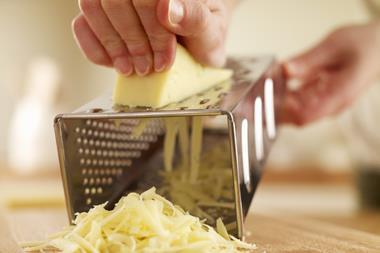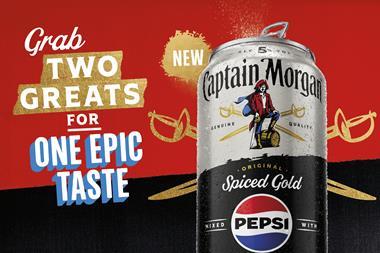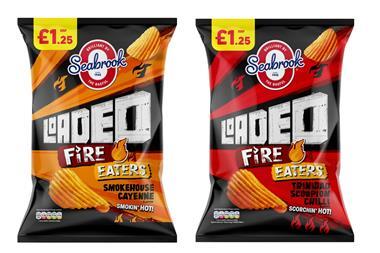Growth in the healthy foods category is picking up speed as we look to lead a healthier life.
Pressure to live a healthier life is coming at consumers from all directions. From TV shows such as Fat Club, Fit Club and You Are What You Eat, to the government’s 5-a-day and salt awareness campaigns, consumers everywhere are being urged to shape up, get fit and eat healthier.
And according to the Food Standards Agency’s sixth UK-wide Consumer Attitudes to Food survey, published this month, they’re listening, too. The annual survey reveals that an increasing number of consumers say they are taking an active interest in their food and diet, with more people checking food labels and trying to eat more fruit and vegetables.
But healthy eating has been a bit of a minefield. One year dieters are all for ditching carbohydrates under Dr Atkins’ orders, and the next carbs are back in vogue, as long as they’re slow-releasing with a low Glycemic Index (GI).
However, according to a report published last month by Datamonitor, the low-carb trend is now dead and low fat is where it’s at. At the height of the Atkins craze in 2004, says the report, 14.1% of new food products claimed to be low-carb, making this the only claim ever to be more widespread than being low fat.
But the popularity was short-lived, says John Band, Datamonitor analyst and author of the study. “This is a powerful illustration of the faddish nature of the diet market,” he says. “The high level of low-carb npd was intimately linked to the temporary popularity of a particular diet, but the ongoing dominant position of low-fat products reflects a long-term consumer health trend.”
The health spotlight has already been turned on supermarkets in a survey by the National Consumer Council which accused the multiples of “pushing” unhealthy foods on shoppers by having too many cut-price promotions on fatty and sugary foods. So offering healthier alternatives in c-stores has never been more important.
For convenience stores, the key is not to get bogged down in the latest diet fads but to offer a healthier alternative across most categories. Weight Watchers head of product licence Elizabeth Egan says: “C-stores could all take on healthier foods if they bear in mind that 10 million women in the UK are overweight, so there are a lot of shoppers looking for an alternative. Retailers have to offer a balance with healthy alternatives across all sections because it’s all about choice for the consumer.”
The Weight Watchers brand is now worth £137m and last year grew by 4%, while some of the supermarket own brands such as Sainsbury’s Be Good o Yourself and Asda Good For You went backwards, says Egan. She adds: “The c-store channel is incredibly important to Weight Watchers. C-stores have been responsive to us and we’ve worked with groups such as Budgens and Londis in creating the right ranges.
“C-stores are important because they have more of a community feel to them and we’re used to working in the community with the weight-loss meetings. There are things we can do together such as stores passing information about the meetings onto customers. But we’ve only just scratched the surface.”
Egan says the brand will continue to enter new categories - the latest being prepacked and deli-counter chilled cooked meats including cooked ham, roast chicken breast, garlic sausage and salami.
The brand has grown on the back of high-profile TV presence for the Weight Watchers meetings, but this year dedicated marketing spend is being put behind food. “The food brand is going to be on TV for the first time,” says Egan. The campaign is worth about £2m and the ads are expected to break in the autumn.
Weight Watchers’ guidelines are: plenty of variety; five portions of fruit and veg a day; cut down on saturated fat; get enough calcium; drink plenty of fluid but limit consumption of tea, coffee and fizzy drinks; and limit sugary foods and alcohol.
“Dieting trends come and go and play into those principles but the guidelines are always the same,” says Egan. “So, for example, while low GI foods such as porridge oats are a great use of points because they fill you up for longer, we’re not promoting a low GI diet.”
The GI craze has sparked launches cashing in on the diet trend. Radnor Hills, for example, has introduced a range of healthy soft drinks called GI Fruits, which are formulated with a low GI and made solely from natural ingredients. GI Fruits is under 55 on the glycemic scale and comes in four flavours - blueberry, orange, apple and lemon & lime.
Meanwhile, Naturally Best has been promoting the Vivaldi potato as a healthier option potato. According to independent tests, Vivaldi potatoes contain on average 26% less carbohydrate and 33% fewer calories than the industry standard. Vivaldi is a year-round potato and available to all independents.
Slim-Fast, the weight loss brand from Unilever, is up for a £6.5m relaunch this month with new packaging and products. New to the range are Real Fruit Smoothies, wet soups and a selection of snacks, all with under 100 calories each.
The smoothies are packed with 30% real fruit, are priced at £1.19 and come in three flavours - raspberry, forest fruits and peach & mango. New Slim-Fast Fruit & Nut Snack Bars contain real fruit, nuts and seeds and come in cranberry & almond and apricot & cashew flavours; new Savoury Snacks sour cream & chive pretzels and Cheddar bites have a rrp of 49p; and the Slim Fast soups are made with real meat and vegetables and come in a pouch format in three varieties - cream of chicken & mushroom, tomato & bean, and chicken & vegetable. They will retail at £1.29.
HEALTHY SNACKS
The Go Ahead brand from United Biscuits UK (UBUK) has had a big impact in bringing better-for-you ranges to convenience stores. This year the company will invest £3m to drive the category, putting an extensive marketing campaign behind a relaunch of Go Ahead. The relaunch includes new savoury bagged snack lines and other products including an extension to the Yogurt Breaks portfolio.
UBUK has a 13.2% share of the £298m healthier biscuit market which is growing at 11.6% year on year, according to AC Neilsen, largely driven by the growth of Yogurt Breaks and Granola Bars.
The bars will now have an increased ‘lower fat’ and ‘lower calorie’ message across the range, highlighting the products’ natural ingredients and taste.
The healthier bagged snacks market is worth £117m, is growing strongly at 31% year on year, and is expected to continue expanding in 2006 as consumers seek healthier snacking alternatives. UBUK is cashing in on this trend with the launch of Go Ahead Crinkly crisps and Go Ahead Crispy Bites.
Crispy Bites are a light potato and rice snacks, available in three flavours - sweet chilli, chicken & herb and mature cheese & pickle. They come in multipacks of four, and the low calorie and fat content is highlighted on pack.
Crinkly crisps, meanwhile, are low in saturated fat and available in lightly salted, cheese & onion and salt & vinegar flavours in multipacks of six. Each pack contains less than 100 calories per pack.
Other recent launches from Go Ahead are a strawberry Yogurt Break and apricot Fruit Tops cereal bar.
UBUK is also targeting the healthier sector with KP Nuts Simply, a range of Tropical Mix and Summer Mix unsalted nuts with fruit, available in 75g handypacks and multipacks.
Walkers Crisps has also jumped on the bandwagon with a relaunch of its core range following a reduction in fat and salt content. The crisps are now cooked in sunseed oil - one of the healthiest oils there is - and contain 70% less saturated fat. The relaunch is being supported by a £20m campaign including a new Gary Linekar ad, which kicked off this month.
There’s also likely to be more activity in this vein from Walkers. General manager Neil Campbell says: “Although this is the biggest single step we have taken - over £6m investment - it isn’t the first and won’t be the last.”
Walkers’ healthier kids’ bagged snack Heads has received a new addition with the launch of Cheese Heads, a baked snack with no artificial colours, flavours or preservatives. Cheese Heads are available in two flavours - cheese and cheese & onion - and come in 27g standard packs and a six-pack. The Heads brand will be supported this year by a £7m campaign, with Cheese Heads receiving £3m of this.
Pepsico has also been extending its healthier snacks brand Quaker Snacks. In December the brand added mini bagels and mini breadsticks to its Snack-a-Jacks range, and announced a £3.5m marketing spend for 2006. At the same time, sun-dried tomato & basil flavour was added to its Seasons range of mini crispbreads, replacing salt & cracked black pepper. Quaker Seasons will benefit from a £2.5m media spend this year.
Kettle Chips has also launched a lower calorie snack range with fewer than 100 calories per pack. Kettle Crispy Bakes have 10% fat and 0.5g of salt per 24g serving, in three flavours: tomato with basil & green peppercorn; korma; and mild cheese & sweet onion. Rrp is 40p.
What is clear in the better-for-you category is that launches and range extensions will continue to come on stream in the near future, but John Band at Datamonitor expects low-sugar and low-calorie confectionery to have the fastest growth in terms of consumers’ expenditure over the next five years. In the UK, it will grow by 3.7% a year until 2009, he predicts.
“The strong growth of the diet confectionery category can be explained by the fact that many consumers, not just dieters, feel the need to indulge with sweets and desserts,” he says. “Many consumers regard sweets as a comfort as well as an indulgence - and choosing a diet alternative to chocolate or sugar confectionery allows consumers to feel less guilty about their indulgence.”
Healthy Attitudes
The 2005 Consumer Attitudes to Food survey by the Food Standards Agency highlights a number of diet trends that have emerged since 2000. These include:
A significant yearly increase in the number of consumers who are aware we should eat at least five portions of fruit and vegetables each day.
A rise in the number of consumers who say they look at nutritional information on food labels. Most check food labels for fat content, followed by salt, then sugar.
An increase in the number of consumers who claim to eat more vegetables, salads and fruit compared with a year ago.
More consumers claim to never eat ready meals (28%).
An increase, from 2003, in the number of consumers who claim to prepare/cook a meal from raw ingredients once a day (54%).
More consumers claim to sit down together for a main meal at least once a day (71%).
Take Five
The 5-a-day message has spawned plenty of launches to help consumers increase their daily consumption of fruit and veg. Campbell’s, for example, has introduced the V8 Fruit & Vegetable juice drink range aimed at families who are looking for an easy way to boost their intake.
The 100% fruit and vegetable drink comes in five flavours - tropical, citrus, orange & mango, apple & melon and vegetable juice. Available in two formats - a 1ltr Tetrapak (rrp £1.49), and a 345ml single-serve bottle (rrp 89p) - the range has been supported by a multi-million pound marketing campaign including TV and outdoor advertising campaigns.
Unilever this January launched its Vie Shot range in a single-pack format. The mini health drinks are made from fruit and vegetable juice and come in two varieties - apple, carrot & strawberry and banana, pumpkin & kiwi. A single bottle has a rrp of 79p. The Vie Shot brand is being supported by a £10m marketing campaign this year.
Pressure to live a healthier life is coming at consumers from all directions. From TV shows such as Fat Club, Fit Club and You Are What You Eat, to the government’s 5-a-day and salt awareness campaigns, consumers everywhere are being urged to shape up, get fit and eat healthier.
And according to the Food Standards Agency’s sixth UK-wide Consumer Attitudes to Food survey, published this month, they’re listening, too. The annual survey reveals that an increasing number of consumers say they are taking an active interest in their food and diet, with more people checking food labels and trying to eat more fruit and vegetables.
But healthy eating has been a bit of a minefield. One year dieters are all for ditching carbohydrates under Dr Atkins’ orders, and the next carbs are back in vogue, as long as they’re slow-releasing with a low Glycemic Index (GI).
However, according to a report published last month by Datamonitor, the low-carb trend is now dead and low fat is where it’s at. At the height of the Atkins craze in 2004, says the report, 14.1% of new food products claimed to be low-carb, making this the only claim ever to be more widespread than being low fat.
But the popularity was short-lived, says John Band, Datamonitor analyst and author of the study. “This is a powerful illustration of the faddish nature of the diet market,” he says. “The high level of low-carb npd was intimately linked to the temporary popularity of a particular diet, but the ongoing dominant position of low-fat products reflects a long-term consumer health trend.”
The health spotlight has already been turned on supermarkets in a survey by the National Consumer Council which accused the multiples of “pushing” unhealthy foods on shoppers by having too many cut-price promotions on fatty and sugary foods. So offering healthier alternatives in c-stores has never been more important.
For convenience stores, the key is not to get bogged down in the latest diet fads but to offer a healthier alternative across most categories. Weight Watchers head of product licence Elizabeth Egan says: “C-stores could all take on healthier foods if they bear in mind that 10 million women in the UK are overweight, so there are a lot of shoppers looking for an alternative. Retailers have to offer a balance with healthy alternatives across all sections because it’s all about choice for the consumer.”
The Weight Watchers brand is now worth £137m and last year grew by 4%, while some of the supermarket own brands such as Sainsbury’s Be Good o Yourself and Asda Good For You went backwards, says Egan. She adds: “The c-store channel is incredibly important to Weight Watchers. C-stores have been responsive to us and we’ve worked with groups such as Budgens and Londis in creating the right ranges.
“C-stores are important because they have more of a community feel to them and we’re used to working in the community with the weight-loss meetings. There are things we can do together such as stores passing information about the meetings onto customers. But we’ve only just scratched the surface.”
Egan says the brand will continue to enter new categories - the latest being prepacked and deli-counter chilled cooked meats including cooked ham, roast chicken breast, garlic sausage and salami.
The brand has grown on the back of high-profile TV presence for the Weight Watchers meetings, but this year dedicated marketing spend is being put behind food. “The food brand is going to be on TV for the first time,” says Egan. The campaign is worth about £2m and the ads are expected to break in the autumn.
Weight Watchers’ guidelines are: plenty of variety; five portions of fruit and veg a day; cut down on saturated fat; get enough calcium; drink plenty of fluid but limit consumption of tea, coffee and fizzy drinks; and limit sugary foods and alcohol.
“Dieting trends come and go and play into those principles but the guidelines are always the same,” says Egan. “So, for example, while low GI foods such as porridge oats are a great use of points because they fill you up for longer, we’re not promoting a low GI diet.”
The GI craze has sparked launches cashing in on the diet trend. Radnor Hills, for example, has introduced a range of healthy soft drinks called GI Fruits, which are formulated with a low GI and made solely from natural ingredients. GI Fruits is under 55 on the glycemic scale and comes in four flavours - blueberry, orange, apple and lemon & lime.
Meanwhile, Naturally Best has been promoting the Vivaldi potato as a healthier option potato. According to independent tests, Vivaldi potatoes contain on average 26% less carbohydrate and 33% fewer calories than the industry standard. Vivaldi is a year-round potato and available to all independents.
Slim-Fast, the weight loss brand from Unilever, is up for a £6.5m relaunch this month with new packaging and products. New to the range are Real Fruit Smoothies, wet soups and a selection of snacks, all with under 100 calories each.
The smoothies are packed with 30% real fruit, are priced at £1.19 and come in three flavours - raspberry, forest fruits and peach & mango. New Slim-Fast Fruit & Nut Snack Bars contain real fruit, nuts and seeds and come in cranberry & almond and apricot & cashew flavours; new Savoury Snacks sour cream & chive pretzels and Cheddar bites have a rrp of 49p; and the Slim Fast soups are made with real meat and vegetables and come in a pouch format in three varieties - cream of chicken & mushroom, tomato & bean, and chicken & vegetable. They will retail at £1.29.
HEALTHY SNACKS
The Go Ahead brand from United Biscuits UK (UBUK) has had a big impact in bringing better-for-you ranges to convenience stores. This year the company will invest £3m to drive the category, putting an extensive marketing campaign behind a relaunch of Go Ahead. The relaunch includes new savoury bagged snack lines and other products including an extension to the Yogurt Breaks portfolio.
UBUK has a 13.2% share of the £298m healthier biscuit market which is growing at 11.6% year on year, according to AC Neilsen, largely driven by the growth of Yogurt Breaks and Granola Bars.
The bars will now have an increased ‘lower fat’ and ‘lower calorie’ message across the range, highlighting the products’ natural ingredients and taste.
The healthier bagged snacks market is worth £117m, is growing strongly at 31% year on year, and is expected to continue expanding in 2006 as consumers seek healthier snacking alternatives. UBUK is cashing in on this trend with the launch of Go Ahead Crinkly crisps and Go Ahead Crispy Bites.
Crispy Bites are a light potato and rice snacks, available in three flavours - sweet chilli, chicken & herb and mature cheese & pickle. They come in multipacks of four, and the low calorie and fat content is highlighted on pack.
Crinkly crisps, meanwhile, are low in saturated fat and available in lightly salted, cheese & onion and salt & vinegar flavours in multipacks of six. Each pack contains less than 100 calories per pack.
Other recent launches from Go Ahead are a strawberry Yogurt Break and apricot Fruit Tops cereal bar.
UBUK is also targeting the healthier sector with KP Nuts Simply, a range of Tropical Mix and Summer Mix unsalted nuts with fruit, available in 75g handypacks and multipacks.
Walkers Crisps has also jumped on the bandwagon with a relaunch of its core range following a reduction in fat and salt content. The crisps are now cooked in sunseed oil - one of the healthiest oils there is - and contain 70% less saturated fat. The relaunch is being supported by a £20m campaign including a new Gary Linekar ad, which kicked off this month.
There’s also likely to be more activity in this vein from Walkers. General manager Neil Campbell says: “Although this is the biggest single step we have taken - over £6m investment - it isn’t the first and won’t be the last.”
Walkers’ healthier kids’ bagged snack Heads has received a new addition with the launch of Cheese Heads, a baked snack with no artificial colours, flavours or preservatives. Cheese Heads are available in two flavours - cheese and cheese & onion - and come in 27g standard packs and a six-pack. The Heads brand will be supported this year by a £7m campaign, with Cheese Heads receiving £3m of this.
Pepsico has also been extending its healthier snacks brand Quaker Snacks. In December the brand added mini bagels and mini breadsticks to its Snack-a-Jacks range, and announced a £3.5m marketing spend for 2006. At the same time, sun-dried tomato & basil flavour was added to its Seasons range of mini crispbreads, replacing salt & cracked black pepper. Quaker Seasons will benefit from a £2.5m media spend this year.
Kettle Chips has also launched a lower calorie snack range with fewer than 100 calories per pack. Kettle Crispy Bakes have 10% fat and 0.5g of salt per 24g serving, in three flavours: tomato with basil & green peppercorn; korma; and mild cheese & sweet onion. Rrp is 40p.
What is clear in the better-for-you category is that launches and range extensions will continue to come on stream in the near future, but John Band at Datamonitor expects low-sugar and low-calorie confectionery to have the fastest growth in terms of consumers’ expenditure over the next five years. In the UK, it will grow by 3.7% a year until 2009, he predicts.
“The strong growth of the diet confectionery category can be explained by the fact that many consumers, not just dieters, feel the need to indulge with sweets and desserts,” he says. “Many consumers regard sweets as a comfort as well as an indulgence - and choosing a diet alternative to chocolate or sugar confectionery allows consumers to feel less guilty about their indulgence.”
Healthy Attitudes
The 2005 Consumer Attitudes to Food survey by the Food Standards Agency highlights a number of diet trends that have emerged since 2000. These include:
A significant yearly increase in the number of consumers who are aware we should eat at least five portions of fruit and vegetables each day.
A rise in the number of consumers who say they look at nutritional information on food labels. Most check food labels for fat content, followed by salt, then sugar.
An increase in the number of consumers who claim to eat more vegetables, salads and fruit compared with a year ago.
More consumers claim to never eat ready meals (28%).
An increase, from 2003, in the number of consumers who claim to prepare/cook a meal from raw ingredients once a day (54%).
More consumers claim to sit down together for a main meal at least once a day (71%).
Take Five
The 5-a-day message has spawned plenty of launches to help consumers increase their daily consumption of fruit and veg. Campbell’s, for example, has introduced the V8 Fruit & Vegetable juice drink range aimed at families who are looking for an easy way to boost their intake.
The 100% fruit and vegetable drink comes in five flavours - tropical, citrus, orange & mango, apple & melon and vegetable juice. Available in two formats - a 1ltr Tetrapak (rrp £1.49), and a 345ml single-serve bottle (rrp 89p) - the range has been supported by a multi-million pound marketing campaign including TV and outdoor advertising campaigns.
Unilever this January launched its Vie Shot range in a single-pack format. The mini health drinks are made from fruit and vegetable juice and come in two varieties - apple, carrot & strawberry and banana, pumpkin & kiwi. A single bottle has a rrp of 79p. The Vie Shot brand is being supported by a £10m marketing campaign this year.























No comments yet